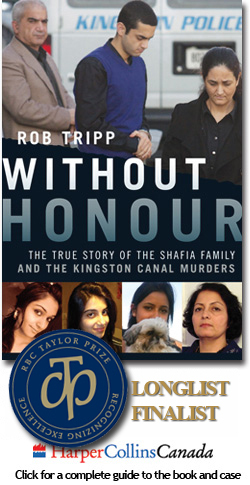Rob Tripp's Blog: Cancrime, page 5
April 11, 2016
Former Quebec justice minister wants unsolved murder inquiry
 A onetime minister of justice in Quebec is lending his voice to demands from the families of murder victims in cases that have long been unsolved. Lawyer Marc Bellemare sent a letter to the province’s public security minister, asking for an inquiry over claims by the families that police have badly mishandled investigations, blocked their access to information and failed to co-operate. Research by John Allore, whose sister Theresa was murdered in 1978, is a principal reason that the issue has been pushed into the spotlight. Allore has, for more than a decade, meticulously researched more than 20 unsolved murders from the 1970s and 80s in Quebec, including his sister’s unsolved case. He has uncovered links that police failed to find and he has exposed police missteps in many investigations. Allore charges, in a series of posts on his website, that police are “completely incompetent.” Allore explains the police failures he has uncovered in Episode 5 of the Cancrime podcast.
A onetime minister of justice in Quebec is lending his voice to demands from the families of murder victims in cases that have long been unsolved. Lawyer Marc Bellemare sent a letter to the province’s public security minister, asking for an inquiry over claims by the families that police have badly mishandled investigations, blocked their access to information and failed to co-operate. Research by John Allore, whose sister Theresa was murdered in 1978, is a principal reason that the issue has been pushed into the spotlight. Allore has, for more than a decade, meticulously researched more than 20 unsolved murders from the 1970s and 80s in Quebec, including his sister’s unsolved case. He has uncovered links that police failed to find and he has exposed police missteps in many investigations. Allore charges, in a series of posts on his website, that police are “completely incompetent.” Allore explains the police failures he has uncovered in Episode 5 of the Cancrime podcast.
April 6, 2016
Unsolved murders blamed on “incompetent” Quebec police

 Police in Quebec have long been among the worst* in Canada at solving murders. Now, one man – bolstered by decades of meticulous research – is challenging this futility with a demand for an inquiry and the formation of a cross-departmental, province-wide cold case squad. John Allore charges that Quebec police are “completely incompetent.” He knows this, he says, because of his dogged research into more than 20 unsolved killings from the 1970s and 80s, including the murder of his 19-year-old sister Theresa. Allore says police deliberately refused to investigate those cases, so he did. Allore uncovered glaring failures in the investigation of Theresa’s November 1978 murder in a small community 150 kilometres east of Montreal. Police wrongly first labelled her death an accident or suicide, fumbled the search for missing clothing and possessions and later discarded important physical evidence that could help identify her killer. More than 37 years after Theresa was killed, the unsolved murder has just been added to the website of the Quebec provincial police force’s cold case unit, thanks to John Allore’s persistence. But he’s not done. Allore (hear him in the Cancrime podcast, after the jump) is pressing for co-operation among departments with unsolved cases that could be connected. His remarkable research and sharp criticism have attracted the attention of senior police officials in Quebec and given hope to families of other victims.
Police in Quebec have long been among the worst* in Canada at solving murders. Now, one man – bolstered by decades of meticulous research – is challenging this futility with a demand for an inquiry and the formation of a cross-departmental, province-wide cold case squad. John Allore charges that Quebec police are “completely incompetent.” He knows this, he says, because of his dogged research into more than 20 unsolved killings from the 1970s and 80s, including the murder of his 19-year-old sister Theresa. Allore says police deliberately refused to investigate those cases, so he did. Allore uncovered glaring failures in the investigation of Theresa’s November 1978 murder in a small community 150 kilometres east of Montreal. Police wrongly first labelled her death an accident or suicide, fumbled the search for missing clothing and possessions and later discarded important physical evidence that could help identify her killer. More than 37 years after Theresa was killed, the unsolved murder has just been added to the website of the Quebec provincial police force’s cold case unit, thanks to John Allore’s persistence. But he’s not done. Allore (hear him in the Cancrime podcast, after the jump) is pressing for co-operation among departments with unsolved cases that could be connected. His remarkable research and sharp criticism have attracted the attention of senior police officials in Quebec and given hope to families of other victims.

John Allore, brother of Theresa Allore, who was murdered in November 1978
You could be forgiven for mistaking John Allore for a trained homicide investigator. He has proved himself a skilled researcher and analyst with unremitting determination. He has found links between unsolved murders that police did not see. He has located physical evidence that police could not. But Allore isn’t a police officer. He’s assistant director of budget and management services in the city of Durham, North Carolina.
He’d like to see the murder of his sister Theresa solved, but he’d also like to see police in Quebec stop making the same mistakes they made in her case nearly four decades ago. Allore, who grew up in Montreal and who was 14 when his sister died, has relentlessly mined information and pressed for action. For roughly 15 years, he has maintained an information-rich website, theresaallore.com, that often discloses details withheld by police about unsolved Quebec murders. His work is so thorough, so provocative, that families of other victims contact him for help, not police.
Allore has secured access to police files, including original notes, autopsy reports and crime scene photos for his sister’s unsolved murder and some other cases. He also obtained a vast library of newspaper clippings on murders in Montreal and surrounding areas from the 1970s and 80s. In 2006, he helped organize a search of an isolated area about 50 kilometres southwest of Lennoxville, where Theresa Allore was attending school at the time she was murdered in 1978. The site may have been a dumping ground for a serial killer, a spot where, unseen, he could discard a body, clothing and other evidence. But Quebec provincial police, the Surete du Quebec, refused to take part in the 2006 search that Allore helped organize and that involved volunteers and family members of other victims. The search uncovered evidence (see photos of the findings in gallery below) that could link the location to several unsolved murders.
After years of slogging through searing autopsy reports and crime scene photos, John Allore has had some success in his pursuit of the truth, but he has grown weary of the failure of Quebec detectives. He accuses them of what he calls “investigative genocide,” a reference to the destruction of evidence and erosion of opportunity to secure eyewitness testimony or confessions because of the passage of time. People are dying. Memories are fading.
Allore’s frustration exploded across the website he maintains in a series of detailed and sometimes emotional posts over the past few months. Allore wrote that he is patient and co-operative, and he has tried to work with police but, he says, “enough is enough.”
“I have lost all belief that my sister’s case will be solved,” Allore wrote, recently. “No longer is the suspect under investigation, it is the investigative agencies that we are now investigating.”
Police have done everything in their power “to NOT solve these crimes,” he wrote. Allore believes that many cases are unsolved because police are understaffed, poorly trained, lazy and incompetent.
“I have been dealing with the Quebec police for 30 years,” John Allore wrote, in a February post on his site. “I think they are completely incompetent. A trained monkey could do a better job of investigation than they could. I am a better investigator than any Quebec law enforcement officer, and I am an amateur. I have a full-time job in government finance. Quebec Police? You are complete idiots.”
The head of the Surete du Quebec’s cold case unit contacted Allore after the blistering public attack. Allore says the SQ official pledged that the unit will add more cases to its public website so that citizens know police are still seeking to solve them and are still soliciting help.
Allore believes his sister may have been the victim of a serial predator who claimed a number of other victims – and he believes other serial predators operated throughout the period. He has identified the unsolved cases of five other women and girls murdered in the late 1970s where there may be links to Theresa. All of the victims were found within a 150-kilometre-long corridor stretching east from Montreal to the city of Sherbrooke. Several of the victims were strangled, in some cases with a bootlace. Quebec investigators have never publicly identified the cases as being linked. But John Allore links them, in part, because of the 2006 search.
The spot was selected because, at that location, on March 25, 1977, the body of a 20-year-old woman, Louise Camirand, was found. Camirand, who lived in Sherbrooke, had been raped and strangled. A bootlace was around her neck. She was naked, except for a glove on her left hand. She had suffered devastating internal injuries, likely from a blunt instrument inserted into her vagina. It appeared she had been killed elsewhere and her body left at the wooded and secluded spot, an area where locals discarded trash.
The 2006 search organized by John Allore uncovered a purse that appeared to match the purse of another unsolved murder victim, Lison Blais, 17, who was found dead in Montreal June 4, 1978. Blais had been struck on the head, choked and raped. The search of the Camirand dumpsite also turned up the remnants of a decaying shoe that appeared to match missing Chinese slippers that Theresa Allore was wearing when she vanished, five months after Lison Blais was murdered. Police never expressed any interest in examining the purse and slipper found at the Camirand dumpsite.
The 2006 search did not locate vital, long-missing evidence in Theresa Allore’s murder. Two hunters passing through the area on November 5, 1978 – two days after Theresa Allore disappeared – reported seeing what appeared to be a woman’s shirt and blue pants, neatly placed on a log. They described a location about three quarters of a kilometre from the spot where Louise Camirand’s body was found. The description matched clothing that Theresa Allore was wearing when she vanished and that was never found. It appears that local police got lost in 1978 trying to find the clothing that the hunters reported seeing.
***
A Chronology: Who killed Theresa?
 » Nov. 3, 1978: Theresa Allore, 19, disappears from Champlain College, in the Lennoxville, Quebec area (a suburb of the city of Sherbrooke) about 150 kilometres east of Montreal.
» Nov. 3, 1978: Theresa Allore, 19, disappears from Champlain College, in the Lennoxville, Quebec area (a suburb of the city of Sherbrooke) about 150 kilometres east of Montreal.
» Nov. 5: Hunters in an isolated area about 50 kilometres southwest of the college report seeing what appeared to be a woman’s shirt and blue pants on a log. A police officer got lost trying to find the items. The spot is about three quarters of a kilometre from the location where murder victim Louise Camirand’s body was found 20 months earlier, on March 25, 1977
» Nov. 10: Police tell Theresa’s father that there isn’t much they can do. They don’t believe she has been murdered. Theresa would probably be found when the snow melted, police say.
» April 13, 1979: Theresa’s body is found at the edge of a river near Compton, about 20 kilometres south of the college. She was naked, except for her bra and underwear. A police investigator notes what appear to be strangulation marks on her neck. In a nearby cornfield, searchers find two pieces of green scarf. Theresa was wearing a green scarf when she vanished. Forensic experts could not establish a cause of death. A final coroner’s report concluded it was “violent death of undetermined nature.”
» April 20, 1979: Theresa’s wallet is found by a farmer on a service road just west of Lennoxville
» 2001: Surete du Quebec tell John Allore that all of the physical evidence in Theresa’s case, including her undergarments and scarf, were discarded. He also learns that physical evidence in at least three other unsolved Quebec murders has been discarded or lost.
» 2006: A search of the area where Camirand’s body was found in 1977 turns up a purse that could belong to another victim and the decaying remnants of a shoe that could be one of Theresa’s missing Chinese slippers that she was wearing when she disappeared.
***
John Allore created an interactive online map that charts the location where some of the cold case victims disappeared and where their bodies were found (click the image below to visit the interactive map):
***
[See image gallery at www.cancrime.com]
* Below is a Statistics Canada report on homicide released in 2005. The report included a rare analysis of the solve rate of murders across Canada over a 30-year span. The report found that Quebec had the lowest solve rate for murder among all provinces. Montreal had the lowest solve rate among big cities, although Laval was second poorest and Longueuil was fourth worst.
Podcast music: Music For Podcasts 2 (Lee Rosevere) / CC BY-SA 4.0
March 30, 2016
Double cop killer ordered to pay after flimsy court claim
 The Federal Court of Canada has thrown out the claim of an imprisoned double cop killer that he’s been defrauded by Corrections Canada and has ordered him to pay $150 to cover CSC’s legal costs. Protonothary Roger Lafrenière cited “radical deficiencies” in Richard Ambrose’s two-paragraph statement of claim and noted that it contained only “bald allegations of fraud and legal conclusions.” Ambrose filed it in January 2016, alleging that Corrections Canada improperly withheld money from him each month for room and board, beginning in October 2010, while he was confined in prisons in Alberta and B.C. Ambrose, who changed his name to Bergeron after his imprisonment for the cold-blooded murders of two Moncton, N.B. police officers in 1974, is well known to prison workers and parole authorities as a bitter, confrontational and sometimes aggressive complainer.
The Federal Court of Canada has thrown out the claim of an imprisoned double cop killer that he’s been defrauded by Corrections Canada and has ordered him to pay $150 to cover CSC’s legal costs. Protonothary Roger Lafrenière cited “radical deficiencies” in Richard Ambrose’s two-paragraph statement of claim and noted that it contained only “bald allegations of fraud and legal conclusions.” Ambrose filed it in January 2016, alleging that Corrections Canada improperly withheld money from him each month for room and board, beginning in October 2010, while he was confined in prisons in Alberta and B.C. Ambrose, who changed his name to Bergeron after his imprisonment for the cold-blooded murders of two Moncton, N.B. police officers in 1974, is well known to prison workers and parole authorities as a bitter, confrontational and sometimes aggressive complainer.
Ambrose claimed that he was improperly denied $50 each month from a WCB cheque he receives. Ambrose was released to Edmonton on full parole in 2000 and fell from a roof while working. He suffered a head injury that he has since claimed wiped out his memory of the murders he committed in 1974 with accomplice James Hutchison. Ambrose’s parole was revoked in 2005 and he was returned to prison. He has been denied in repeated bids for freedom. Ambrose’s claim named the Correctional Service of Canada, Bowden Institution in Alberta and Matsqui Institution in British Columbia as respondents. The two paragraphs of his claim were reproduced in Lafrenière’s decision:
“1.The Plaintiff claims the CSC did commit fraud on the Plaintiff by charging him $50.00 room and board on his monthly WCB cheque every month. It was also a violation of Commissioner’s Directive 860-21. From October 2010 to Sept. 2013, in October 2013 I was charged $180.00 for room and board totals $1980 plus $2.05 fraud on postage.
2.Plaintiff claims Matsqui CSC committed fraud on him via depriving him of pay from September 2014 to present so approximately $320.00.”
Federal prisoners typically surrender 22 per cent of their inmate pay to Corrections Canada to cover food and accommodation costs but prisoners who have additional sources of income are typically required to contribute 30 per cent of the additional money toward food and accommodation costs. An inmate can earn a maximum of $6.90 daily for work at a prison job.
The federal court noted that Corrections Canada brought a motion to “strike” Ambrose’s claim and he failed to respond, despite being “duly served.” The decision concluded that Ambrose, who represented himself in the claim, didn’t properly identify the defendants, and he failed to provide any details of the alleged fraud perpetrated against him:
“The Plaintiff has failed to plead any particulars of fraud, such as what specific representation was made to him, what was false in the said representation, who made the representation and when the representation was made. The Plaintiff has also failed to plead that the person (or persons) who made the representation intended to deceive the Plaintiff or induce him to act or alter his position.”
Ambrose and Hutchison were sentenced to hang after they killed Const. Michael O’Leary and Cpl. Aurele Bourgeois on Dec. 13, 1974. The officers were pushed into a shallow grave and shot in the head. Hutchison was on parole in New Brunswick at the time of the murders from a sentence for armed robbery. He had already amassed a 30-year record of violent crimes. The death sentences were commuted to life in prison, with no chance of parole for 25 years, after capital punishment was abolished in 1976. Hutchison died behind bars in June 2011.
Here’s the decision of the Federal Court of Canada, dated February 22, 2016, rejecting Ambrose’s fraud claim:
» Complete story of the 1974 murders
» Ambrose’s latest parole records
March 24, 2016
Judge cites “deceptive” accusers in acquitting Ghomeshi
 Former radio star Jian Ghomeshi (inset) is not guilty of four sexual assaults and one charge of choking, a judge in Toronto ruled today, citing the “deceptive and manipulative” evidence of his accusers. The charges were laid against the former CBC personality after allegations that he assaulted three women between 2002 and 2003. The judge in the sensational case, William Horkins, made it clear in his ruling (read complete decision after the jump) that a finding of “not guilty” doesn’t mean the incidents didn’t happen. Horkins wrote that his finding “is not the same as deciding in any positive way that these events never happened.” But Horkins had harsh criticism for the accusers, saying he found it impossible to have “sufficient faith in the reliability or sincerity of these complainants.”
Former radio star Jian Ghomeshi (inset) is not guilty of four sexual assaults and one charge of choking, a judge in Toronto ruled today, citing the “deceptive and manipulative” evidence of his accusers. The charges were laid against the former CBC personality after allegations that he assaulted three women between 2002 and 2003. The judge in the sensational case, William Horkins, made it clear in his ruling (read complete decision after the jump) that a finding of “not guilty” doesn’t mean the incidents didn’t happen. Horkins wrote that his finding “is not the same as deciding in any positive way that these events never happened.” But Horkins had harsh criticism for the accusers, saying he found it impossible to have “sufficient faith in the reliability or sincerity of these complainants.”
Here’s the ruling released today (March 24, 2016) by Ontario judge William Horkins, following Ghomeshi’s eight-day trial in February:
Ghomeshi faces another trial in June on a single sexual assault.
March 20, 2016
Records hint at Black Widow’s real identity – serial killer, psychopath
 We may never know exactly how many times Melissa Ann Shephard (inset) has killed. In a criminal career that spans five decades, Shephard has sown confusion, obfuscated with layers of lies and masqueraded as a victim. The criminal justice system, unable to affix the damning labels she may deserve – serial killer, psychopath – continues to turn her loose to kill again and struggles to contain her. She has learned from her criminal mistakes and profited from her predation. Infamous as the ‘Internet Black Widow,’ Shephard was released Friday (March 18, 2016) from a women’s prison in Nova Scotia – amid a police warning – after her latest stint behind bars, a three-and-a-half year sentence. It was imposed in 2013 after she admitting spiking drinks of her newlywed fifth husband, 74-year-old Fred Weeks, with potent tranquilizers. An attempted murder charge was dropped when Shephard pleaded guilty to lesser charges. Two of Shephard’s four husbands who preceded Weeks ended up dead and another mysteriously fell ill immediately after meeting Shephard. Recent prison assessments (read what experts say, in internal documents after the jump) warn that Shephard scores high for some psychopathic traits, she is resistant to treatment and indifferent to the suffering of her victims. The only thing that has contained her lethal greed in the past 40+ years has been time behind bars and yet, the system has refused to apply the brand that could keep her locked up.
We may never know exactly how many times Melissa Ann Shephard (inset) has killed. In a criminal career that spans five decades, Shephard has sown confusion, obfuscated with layers of lies and masqueraded as a victim. The criminal justice system, unable to affix the damning labels she may deserve – serial killer, psychopath – continues to turn her loose to kill again and struggles to contain her. She has learned from her criminal mistakes and profited from her predation. Infamous as the ‘Internet Black Widow,’ Shephard was released Friday (March 18, 2016) from a women’s prison in Nova Scotia – amid a police warning – after her latest stint behind bars, a three-and-a-half year sentence. It was imposed in 2013 after she admitting spiking drinks of her newlywed fifth husband, 74-year-old Fred Weeks, with potent tranquilizers. An attempted murder charge was dropped when Shephard pleaded guilty to lesser charges. Two of Shephard’s four husbands who preceded Weeks ended up dead and another mysteriously fell ill immediately after meeting Shephard. Recent prison assessments (read what experts say, in internal documents after the jump) warn that Shephard scores high for some psychopathic traits, she is resistant to treatment and indifferent to the suffering of her victims. The only thing that has contained her lethal greed in the past 40+ years has been time behind bars and yet, the system has refused to apply the brand that could keep her locked up.
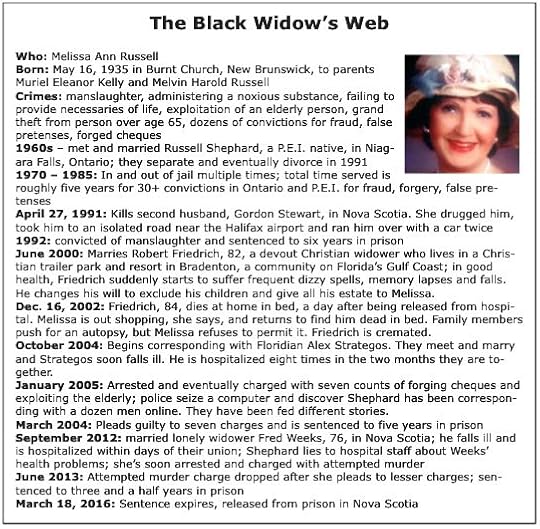 Authorities in Halifax, where Shephard will live after her release from prison, are so concerned about her presence that a public warning was issued (read full release below) on Friday, March 18 by Halifax police, including a recent photo of Shephard. Police caution that Shephard “has a “history of violent criminal convictions dating back to 1992″ and she “has been assessed as being a high risk to re-offend.”
Authorities in Halifax, where Shephard will live after her release from prison, are so concerned about her presence that a public warning was issued (read full release below) on Friday, March 18 by Halifax police, including a recent photo of Shephard. Police caution that Shephard “has a “history of violent criminal convictions dating back to 1992″ and she “has been assessed as being a high risk to re-offend.”
Police clearly fear Shephard will strike again. Remarkable conditions have been imposed, including an order that requires her to tell police about any possible romantic relationship, cohabitation or marriage, so that officers can explain her criminal background to her potential partners. It’s a luxury that four men victimized by Shephard did not have. She’s also barred from using the Internet, the hunting ground where she found most of her targets.
The conditions are impossibly difficult to enforce, particularly in the case of a criminal who has been set free at the expiry of her sentence. Shephard served every day of her latest term. The opportunity to delcare her a dangerous offender (DO), a designation that could have permited authorities to keep her locked up forever, passed. A DO application is typically brought forward by the prosecution immediately after conviction but before sentencing. An application can be made up to six months after sentencing, if new information comes to light. In 2008, criminal law was tightened to provide that a habitual criminal who had committed three serious offences was, presumptively, a dangerous offender. Shephard has been convicted three times of serious, violent crimes, including manslaughter, that earned her penitentiary terms, yet no effort was made to designate her a dangerous offender. This is why police are left with the difficult task of enforcing conditions that Shephard can easily circumvent.
There’s no reason to believe that Shephard, despite her age, will abide the rules or give up her predatory behaviour. In prison, she was caught hoarding medicine and fabricating stories. Expert assessments revealed that she did not respond to treatment.
“You continue to display a substantial degree of indifference … to your elderly vulnerable victims,” states a December 2014 parole document.
A psychological risk assessment completed in 2014, and which employed a widely accepted test for psychopathy, the Hare PCL-R, found that Shephard’s “score on Factor 1 items was notably high for traits related to psychopathy.”
“The psychologist noted that your criminal history is disturbing in that it is not clearly and explicitly recorded as a pattern of violence,” the record of the 2014 parole board decision states. “However, he described your behaviour as highly suspect and that your intent, if not murderous, was endangerment of life, showing wanton and reckless disregard for the lives or the safety of the men with whom you were romantically involved. He went on to caution as to the potential for volatility with respect to the management of your case.” (emphasis added) After the hearing in December 2014, the board ordered Shephard kept behind bars until she had served every day of her sentence, because she was “a significant threat to your target group of elderly vulnerable men” and too dangerous for early release on parole.
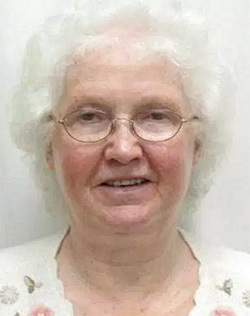
Recent photo of the ‘Internet Black Widow’ Melissa Ann Shephard, released by Halifax police on Friday, March 18, 2016
While Shephard has been convicted only once of manslaughter, in the death of her second husband, family members of Shephard’s third husband, Robert Friedrich, who died under suspicious circumstances and was quickly cremated, believe she poisoned him. Alex Strategos, her fourth husband, believes that Shephard spiked his food with prescription drugs in a bid to kill him and steal his life savings. The 73-year-old was hospitalized soon after meeting Shephard. They met through an online dating site. Police in Florida believed Shephard poisoned Strategos to get his assets.
“I truly do think she was either trying to incapacitate him enough to perform the crimes that she was doing, or actually end up ultimately killing him, which is what I think what would have happened to him,” Pinellas Park detective Sgt. Mark Lynch has said.
Police couldn’t gather enough evidence for an attempted murder charge but succeeded in convicting Shephard of seven crimes related to exploitation and defrauding a senior. She was sentenced to five years in an American prison. Her latest victim, Nova Scotian Fred Weeks, also has said that he believed she was trying to kill him.
“She was trying to kill me … there’s no doubt in my mind,” Weeks said, in an interview with CBC in 2013.
Shephard was released from her U.S. sentence in 2009. Within three years, she had stalked and poisoned Fred Weeks. The potent prescription drug benzodiazepine was found in his body. The same drug was found in Alex Strategos. The problem for police investigators has been connecting Shephard to the drugs found in the bodies of her victims. Tests done on Alex Strategos when he was hospitalized did not establish how much drug was in his system and police could not prove that he didn’t take it himself. Shephard seems to have learned that poisoning homicides are notoriously difficult for investigators. Symptoms often mimic natural disease and because murder-by-poison is rare, it is easily overlooked.
Poisoning hasn’t always been Shephard’s principal criminal enterprise.
She was born in a small fishing community in New Brunswick and began her criminal career as a petty thief and cheque forger. Between 1970 and 1985, she was in and out of jail in Ontario and Prince Edward Island, accumulating roughly five years behind bars for more than 30 convictions for fraud and related crimes.
She earned her first penitentiary term after the death of her second husband, Gordon Stewart, in Nova Scotia in 1991. Shephard went to trial on a charge of second-degree murder. She claimed Stewart was an abusive alcoholic who abducted and raped her before she killed him in self defence. Evidence showed that Shephard drugged Stewart, then ran him over with a car twice on an isolated road near the Halifax airport. Forensic tests found no evidence she had been assaulted. A toxicologist testified at the trial that Stewart was so full of prescription drugs and several kinds of alcohol that he likely would have been unconscious at the time he was run over. Two shopping bags filled with prescription drugs were found in Shephard’s apartment. Convicted of manslaughter, Shephard was sentenced to six years in prison. She had killed Stewart after draining his bank account and stealing his pension payments.
Her third husband, lonely widower Robert Friedrich, was dead two years after meeting Shephard. The couple were engaged three days after meeting at Friedrich’s home in Bradenton, Florida, in May 2000. Five months after they wed, Friedrich called his adult children to tell them he was changing his will to leave all of his estate to Shephard. Friedrich became strangely ill soon after he married Shephard. He began falling, necessitating hospital visits and nursing home stays. Friends couldn’t understand his sudden decline. He was hospitalized seven or eight times in his two years with Shephard. Records obtained later by family revealed that toxicology tests were not performed when Friedrich was hospitalized, according to a sweeping investigation of Shephard by my former colleague at The Kingston Whig-Standard newspaper, Tamsin McMahon. McMahon spent roughly a month criss-crossing North America, interviewing 30 people who knew Shephard. Her investigation included a revealing jailhouse interview with Shephard in Florida. In April 2005, the Whig published a novella-length, five-part series based on McMahon’s work that exposed Shephard’s many lies and the depth of her murderous greed.
On December 15, 2002, Robert Friedrich, 84, was rushed to hospital. McMahon’s investigation revealed that:
Melissa had called an ambulance, saying Robert was suffering from severe stomach pains, had been going in and out of consciousness and had been up vomiting since 2 a.m. In their notes, paramedics wrote that Robert’s story “completely conflicts with what [the] patient’s wife is saying. Patient denies abdominal pain. Admits one nausea episode and states he slept soundly all night,” the notes read.
Under [the heading] ‘chief complaint,’ a nurse at Manatee Memorial Hospital wrote that Robert had said: “I don’t know why I’m here.” His vital signs were normal, except for a racing heart. He was treated and released that day.
On Dec. 16, a day after he returned home from the hospital, Robert Friedrich died.
The death of an 84-year-old man at home in his bed hardly raised eyebrows in the retirement community. The doctor who signed the death certificate over the phone listed the cause of death as cardiac arrest.
It appears no one examined Robert’s body before he was cremated.
Melissa was out shopping when her husband died.
“They gave me a prescription I had to fill for him,” Shephard [told reporter McMahon]. “I went out to the drug store to get the medication and while I was away, this happened. When I got back home he was already dead in bed.”
Melissa said she shook Robert and tried to perform CPR before calling 911.
“He died of natural causes,” she said. “He had heart failure and he had had a stroke and cardiac arrest all at the same time. The doctor said that the cause of death was a massive heart attack. He died in bed at home and he was glad to be at home.”
Friedrich’s family members are convinced that Shephard poisoned Robert with prescription drugs. They found credit card receipts showing that Shephard was obtaining prescription drugs from different doctors. American police drew up six charges against Shephard for doctor shopping for illegally obtaining prescriptions from six different doctors for pain killers and benzodiazepines, a class of tranquilizers that work by slowing the central nervous system. The charges weren’t filed because prosecutors said they could not prove that Shephard withheld information from the doctors she visited.
In 2005, Manatee, Fla., police opened an investigation into Friedrich’s death, but it did not lead to charges. McMahon reported, in her expose:
Police spokesman Dave Bristow said that with no body and no autopsy it’s unlikely that charges will ever be filed. “This is an 84-year-old man who died and had a heart condition and his body was cremated very quickly and a doctor signed a death certificate,” Bristow said, in an interview. “We’re doing all we can do with very limited evidence and information. We don’t even know if there was any wrongdoing.”
Robert Friedrich’s son Dennis told McMahon: “I know my father was drugged to death. I can’t prove it, but I know it.”
***
The written records of the two most recent decisions in Shephard’s case by the Parole Board of Canada: The November 2015 decision confirming the order to keep her locked up until the expiry of her sentence and, the December 2014 original detention decision:
***
The “High Risk Offender Notification” issued by Halifax Police on March 18, 2016:
High Risk Offender NotificationPolice Media Releases – Friday, Mar 18, 2016 at 1:18pm
In accordance with the Nova Scotia Release of High Risk Offender Information Protocol, Halifax Regional Police is advising all citizens, particularly those in the Halifax Regional Municipality, that a high risk offender is residing in our community.
Melissa Ann Shephard, 80, was released from the Nova Institution for Women today, after completing a sentence for serious assaults against her intimate partners, including administering noxious things and not providing the necessities of life for which she was sentenced in June 2013. Shephard has a history of violent criminal convictions dating back to 1992 that includes a conviction for manslaughter. Shephard has been assessed as being a high risk to re-offend. Her victims have included her intimate partners consisting of elderly men.
Shephard will be on a recognizance and will be required to follow a multitude of strict conditions, some of which include:
should she alter her appearance, she shall upon a demand by a police/peace officer, submit to having her current photograph taken
she shall not access the internet or be in the possession of, any device that is capable of accessing the internet
she shall make no attempt to communicate, directly or indirectly with any of her past victims or family members of the victims in the case in which she was convicted
she is not to enter into any romantic relationship, cohabitation, common-law relationship, or marriage until that person has been identified by a member of the police agency where she resides and there has been a reasonable opportunity provided to the said police agency to inform them of her history in these and other legal proceedings.Shephard is an 80-year-old white woman, 5’5”, 181 lbs, with white hair and hazel eyes.
This information is provided to alert members of the public of her presence in our community. Any form of vigilante activity or other unreasonable conduct will not be tolerated.
March 11, 2016
Prisons watchdog report suppressed for nine months
 Canadians spent $2.5 billion last year to operate the country’s penitentiary system, so you’d expect they’d be entitled to timely information about how it’s functioning. They’re not getting it. A key report on the operation of Correctional Service of Canada was suppressed by the previous Conservative regime and was withheld from public release by the new Liberal government for five months. The annual report of correctional investigator Howard Sapers, an ombudsman who is mandated by law to investigate prisoner complaints, was released publicly yesterday (March 10), nine months after Sapers gave it to Conservative Public Safety Minster Steven Blaney.
Canadians spent $2.5 billion last year to operate the country’s penitentiary system, so you’d expect they’d be entitled to timely information about how it’s functioning. They’re not getting it. A key report on the operation of Correctional Service of Canada was suppressed by the previous Conservative regime and was withheld from public release by the new Liberal government for five months. The annual report of correctional investigator Howard Sapers, an ombudsman who is mandated by law to investigate prisoner complaints, was released publicly yesterday (March 10), nine months after Sapers gave it to Conservative Public Safety Minster Steven Blaney.
In an interview in January 2016, Sapers told me that he gave the report, as always, to Blaney at the of June 2015.
“We asked the minister, when it was clear that an election was in the offing, we asked the minister to make arrangements to table the report ahead of the election,” Sapers told me. “In fact, arrangements were made to have an out-of-session tabling and, at the very last minute, the minister decided not to do that and one of the first things I did when I met with the new minster after the election was ask that the annual report be tabled as soon as possible.”
Sapers had no explanation for the delay in the public release of his report, but to understand the strategies of the Conservatives, read Mark Bourrie’s insightful Kill the Messengers, which portrays the Harper regime as an “anti-intellectual government” that conducted business in private. We can surmise that the Tories didn’t want public scrutiny of prison operations in the runup to the October federal election, particularly given the troubling tone of Sapers’ report.
It notes that Canada’s criminal justice system has grown far more harsh and spending has skyrocketed. Total criminal justice costs – police, courts, corrections, parole – rose almost 25% in the last decade.
Violence and death inside penitentiaries increased – what Sapers calls the progressive deterioration of “safe custody indicators.” The report states: “The number of use of force incidents have almost doubled, admissions to administrative segregation increased by 15.5%, incidents of prison self-injury have tripled, prison crowding hit all-time highs and parole grant rates bottomed out.”
Sapers highlights the fact that corrections spending ballooned by 70 per cent between 2003 and 2013. The prison population increased by 10 per cent, driven, in part, by harsh sentences, including more mandatory minimums. They were imposed despite good evidence that they’re counterproductive and do nothing to improve public safety. The Tories also engineered the biggest expansion of Canada’s penitentiary industry in decades, as 2,700 more cells were built in 30 prisons at a cost of $700 million.
Sapers report makes 18 recommendations, including a call for an end to the use of solitary confinement for mentally ill inmates.
In just over three months, he will provide his next annual report to the new Liberal minster.
March 10, 2016
Psychopathic sex predator back behind bars
 Psychopath and sex predator Don Gazley – who is profiled in Episode 4 of the podcast – is back behind bars, weeks after he was released from a federal institution in British Columbia, Cancrime learned. “Don Gazley is currently in custody at a federal institution,” Jean-Paul Lorieau, a B.C.-based spokesman for Correctional Service of Canada told me today (March 10). Lorieau won’t say why Gazley’s release was revoked. Gazley was deemed a high risk to commit new sex crimes against children so he was kept locked up until he had served every day of his last sentence, an eight-year term for sex crimes committed in Ontario.
Psychopath and sex predator Don Gazley – who is profiled in Episode 4 of the podcast – is back behind bars, weeks after he was released from a federal institution in British Columbia, Cancrime learned. “Don Gazley is currently in custody at a federal institution,” Jean-Paul Lorieau, a B.C.-based spokesman for Correctional Service of Canada told me today (March 10). Lorieau won’t say why Gazley’s release was revoked. Gazley was deemed a high risk to commit new sex crimes against children so he was kept locked up until he had served every day of his last sentence, an eight-year term for sex crimes committed in Ontario.
Gazley was freed from prison in early January, after his eight-year sentence expired, but he’s subject to a long-term supervision order for 10 years. It’s a legal leash reserved for dangerous and violent criminals that permits authorities to impose conditions and keep tabs on the offender. Gazley was ordered to stay at a halfway house or other residential facility for 180 days and was ordered to have no contact with children unless he was accompanied by an adult who knows his criminal history and who is approved by his parole supervisor. Five other special conditions were imposed.
The parole documents outlining his conditions note that a parole officer or duty officer “will be able to issue a warrant and temporarily return the offender to prison, if the officer believes that the risk to the public has become unmanageable.”
A Corrections Canada parole officer can refer Gazley to the parole board for a hearing, if he feels there’s been a serious breach of his conditions, or he can choose to cancel the suspension and turn him loose again. If Gazley is referred to the parole board, it will hold a hearing and can recommend to a Crown prosecutor that a charge be laid. A conviction for violating parole conditions carries a maximum sentence of two years in penitentiary. The parole board also could choose to cancel the suspension and release Gazley.
If Gazley was returned to custody after a conviction, the clock on his 10-year supervision order would stop counting down.
March 7, 2016
Another psychopath and sex predator freed from prison
 There may be 3,500
There may be 3,500 psychopaths behind bars in Canada’s prisons, roughly one quarter the male penitentiary population, according to researchers. They are conscienceless predators and manipulators driven only by a desire for self-gratification. Until recently, Don Gazley (inset) was among them. Gazley (listen to him, after the jump, in manipulation mode, in Episode 4 of the Cancrime podcast) has a two-decade history of sex crimes and involvement in a murder. He’s been diagnosed a “classic psychopath” who poses a high risk to commit new sex crimes. Yet Gazley was released in early January from a penitentiary in British Columbia, in part, because the top legal official in Ontario, where he was last sentenced, chose not to seek to keep him locked up forever through a dangerous offender designation. Gazley’s treatment by the criminal justice system isn’t unusual. A Canadian expert on psychopaths, forensic psychologist Stephen Porter, says the system must take psychopathy “much more seriously.” His research reveals that, although psychopathy is one of the most powerful predictors of criminal recidivism, psychopaths win conditional release 2.5 times more often than non psychopaths.
psychopaths behind bars in Canada’s prisons, roughly one quarter the male penitentiary population, according to researchers. They are conscienceless predators and manipulators driven only by a desire for self-gratification. Until recently, Don Gazley (inset) was among them. Gazley (listen to him, after the jump, in manipulation mode, in Episode 4 of the Cancrime podcast) has a two-decade history of sex crimes and involvement in a murder. He’s been diagnosed a “classic psychopath” who poses a high risk to commit new sex crimes. Yet Gazley was released in early January from a penitentiary in British Columbia, in part, because the top legal official in Ontario, where he was last sentenced, chose not to seek to keep him locked up forever through a dangerous offender designation. Gazley’s treatment by the criminal justice system isn’t unusual. A Canadian expert on psychopaths, forensic psychologist Stephen Porter, says the system must take psychopathy “much more seriously.” His research reveals that, although psychopathy is one of the most powerful predictors of criminal recidivism, psychopaths win conditional release 2.5 times more often than non psychopaths.
***
 Porter believes psychopaths get out of prison early, in part, because they fool decision makers with “Academy-award winning” emotional performances (Porter explains this, in more detail, in the podcast). He calls psychopaths “emotional chameleons” that are expert at faking feelings, yet they feel virtually no true emotion themselves. They lack empathy and remorse, are selfish, callous, impulsive and manipulative. One psychopath can cause widespread destruction. Serial child killer Clifford Olson, who murdered at least 11 children, and serial rapist and murderer Paul Bernardo, are two infamous Canadian psychopaths. Olson scored 38 out of 40 on a psychopathy test developed by noted Canadian researcher Robert Hare.
Porter believes psychopaths get out of prison early, in part, because they fool decision makers with “Academy-award winning” emotional performances (Porter explains this, in more detail, in the podcast). He calls psychopaths “emotional chameleons” that are expert at faking feelings, yet they feel virtually no true emotion themselves. They lack empathy and remorse, are selfish, callous, impulsive and manipulative. One psychopath can cause widespread destruction. Serial child killer Clifford Olson, who murdered at least 11 children, and serial rapist and murderer Paul Bernardo, are two infamous Canadian psychopaths. Olson scored 38 out of 40 on a psychopathy test developed by noted Canadian researcher Robert Hare.
Although professionals have good tools, like Hare’s test, to identify psychopaths and we know well the horrible damage they can inflict, each year, only a handful of psychopaths are declared dangerous offenders. It’s a legal designation that permits authorities to keep a criminal locked up until he’s deemed no longer a danger to society. In practice, most dangerous offenders are never released and die behind bars. Authorities have been far more willing to use another measure in criminal law, a far less restrictive tactic, with dangerous and persistent criminals. A long-term supervision order, which can last for 10 years, can be imposed. It permits authorities to attempt to monitor and control an offender when his sentence expires and he’s free in the community.

Forensic psychologist Stephen Porter of UBC Okanagan
Gazley, 55, is subject to a 10-year long-term supervision order that was imposed when he was sentenced in Ottawa, Ontario in 2008 to eight years in prison for sex crimes involving a 14-year-old girl and a 13-year-old boy with a learning disability. Ontario’s Attorney General declined to seek a dangerous offender designation for Gazley, even though the 2008 convictions were part of a two-decade pattern of sex crimes against children and vulnerable adults and long after he was first diagnosed as a psychopath. At his sentencing in 2008, ever the manipulator, Gazley sobbed and pleaded with the judge to be lenient, claiming that the sentence wasn’t what he had agreed to in a plea bargain. The judge ignored Gazley.
Gazley’s sentence expired on January 4, 2016 and that’s why he had to be released from prison. In the years leading up to the expiry of his penitentiary term, he had fought for early release but was repeatedly turned down because of warnings by professionals that he still posed a high risk to commit new sex crimes (read about his failed attempts for early release in parole documents below.)
The Parole Board of Canada imposed seven conditions on Gazley’s long-term supervision order, including the requirement that he live at a halfway house for 180 days. The parole records don’t reveal where Gazley was sent, but in earlier parole hearings he had asked for permission to return to Ontario, where he has family. He’s also barred from being in the presence of any boys or girls under age 18 unless accompanied by an approved adult who knows his criminal history. He was ordered to report to his parole supervisor all relationships and friendships with anyone who has parental responsibility for children under the age of 18 and he must participate in counselling.
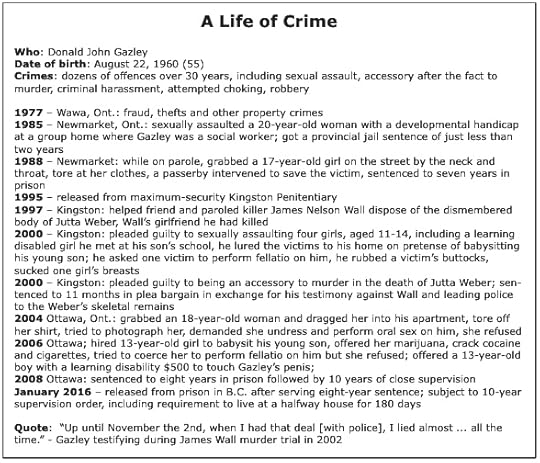 If Gazley violates his conditions, a parole officer can issue a warrant suspending his parole. Gazley would be taken into custody. The officer can choose, very quickly, to cancel the suspension or he can send a report to the parole board, which will hold a hearing. The board can cancel the suspension or recommend to a Crown attorney that charges be filed against him for breaching his parole conditions. A conviction for violating parole conditions carries a maximum sentence of two years in penitentiary. If Gazley was returned to custody after a conviction, the clock on his 10-year supervision order stops counting down.
If Gazley violates his conditions, a parole officer can issue a warrant suspending his parole. Gazley would be taken into custody. The officer can choose, very quickly, to cancel the suspension or he can send a report to the parole board, which will hold a hearing. The board can cancel the suspension or recommend to a Crown attorney that charges be filed against him for breaching his parole conditions. A conviction for violating parole conditions carries a maximum sentence of two years in penitentiary. If Gazley was returned to custody after a conviction, the clock on his 10-year supervision order stops counting down.
I have interviewed Gazley dozens of times. I’m not sure anything he ever said, to me – or for that matter, to psychiatrists, psychologists, lawyers, and police officers – was the whole truth. Gazley is a ceaseless liar and manipulator. In 2002, Gazley testified at the murder trial of his friend James Wall that he “lied almost … all the time,” until he had a signed deal with authorities for a lenient sentence for his involvement in the murder in exchange for his testimony against Wall. Wall was convicted on Gazley’s testimony, which was the only evidence that linked Wall to the crime. In an interview after the trial, Gazley told me: “I know I’m not a true psychopath because I have feelings about this.” He also told me, cryptically, that there was “more to the story” of the murder, though he refused to elaborate.
One of Gazley’s familiar patterns of offending was to hire young girls, typically around age 13, to babysit his young son. Once in his home, the girls would be offered drugs and alcohol and pressured to perform sex acts. After I wrote about Gazley’s conviction in 2008 on sex charges in Ottawa, he called from behind bars to complain about how he feared the coverage would hurt his then-teenage son and other family members who lived in Ontario. In yet another remarkable moment of emotional manipulation, Gazley asked if I had my “pound of flesh,” accusing me of exploiting his misfortune in a way that hurt others (Listen to this exchange with Gazley in Episode 4 of the podcast, embedded here and available on iTunes).
Below are the written records of five separate Parole Board of Canada decisions involving Gazley between 2013 and 2016. The details of the conditions imposed on his 10-year long-term supervision order appear in the final record, pages 21- 24 (on mobile? click here to read docs)
» Read more about Stephen Porter’s research on sexual psychopaths
March 6, 2016
Three reasons Shafia honour killing appeals likely to fail
 The three convicted Shafia family killers want new trials and Hamed Shafia, the youngest of the trio, wants to be retried or, at least, re-sentenced, as a youth. A panel of judges of Ontario’s top court is grappling with these demands following a two-day hearing this week in Toronto at the Court of Appeal for Ontario. The judges reserved judgment. There’s no timetable for a decision from the court. I think it’s unlikely the Shafias will be successful, on any of their grounds, because, as with some of their outlandish claims during their murder trial, they just can’t be believed.
The three convicted Shafia family killers want new trials and Hamed Shafia, the youngest of the trio, wants to be retried or, at least, re-sentenced, as a youth. A panel of judges of Ontario’s top court is grappling with these demands following a two-day hearing this week in Toronto at the Court of Appeal for Ontario. The judges reserved judgment. There’s no timetable for a decision from the court. I think it’s unlikely the Shafias will be successful, on any of their grounds, because, as with some of their outlandish claims during their murder trial, they just can’t be believed.
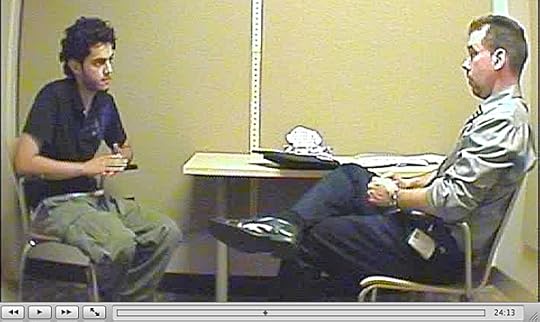
Hamed Shafia, in one of many police interviews in which he lied about not being at the canal the night his four family members died, June 30, 2009 (screengrab from police video entered as exhibit at murder trial)
Number 1: The Shafias are admitted liars who have not given reasonable and believable answers to key questions: During her testimony during the murder trial, Tooba said she told “all lies” to a police interrogator about being at the canal when the four family members died because she wanted to “save” Hamed from what she believed was impending torture by police. Convincing the appeal court Hamed wasn’t an adult at the time of the murders and is entitled to parole much sooner might also amount to “saving” him.
Mohammad Shafia admitted during his trial testimony that he lied on immigration documents. When he applied to bring his family to Canada, he falsely claimed that Rona Amir was his cousin and housekeeper, concealing her true identity as his first wife. He continued the charade, even after Rona’s death.
Although Hamed didn’t testify at trial, his conversation with a private investigator was admitted as evidence. It revealed that Hamed lied repeatedly to police interrogators. He told officers that he wasn’t at the canal the night his sisters and Rona went into the water. But Hamed told the PI he was there. He spun a story that stretched credulity about following the Nissan Sentra carrying his four family members to the canal, while he was driving the family’s other vehicle, an SUV. In the interview with the PI, Hamed said Zainab drove the Sentra into the water by accident. Hamed said he stood at the lip of the canal, called out to them and dangled a rope, but did not jump in to try to save them and did not call 9-1-1 or his parents. Immediately afterward, he drove to Montreal from Kingston, Ontario. Hamed never told his parents this story, he claimed. Hamed’s explanation for doing virtually nothing to try to save his four family members was wholly inconsistent with the portrait the family presented at trial of a loving, happy and caring clan; he told the PI that he feared he’d get in trouble so he chose to tell no one that he’d watched his beloved sisters and other mother drown.
Zafar*, the youngest Shafia boy, testified at the trial that he lied to and manipulated police and teachers in claims of physical abuse by his father and older brother – claims that he later recanted. The boy, 18 at the time of his testimony at the murder trial, insisted that he was telling the truth when he testified that he might have done an incriminating online search using a family computer (recovered by a forensic police examiner) for “where to commit a murder,” during a depressed state. He claimed he didn’t understand the word “suicidal” and wrongly inserted “murder.” The boy had attended an English school in Dubai until age 13.

The victims (clockwise from top left) Zainab, Sahar, Rona, Geeti
Number 2: The reconstituted timeline of the Shafia family, based on Hamed’s birth in December 1991, doesn’t make sense: Mohammad Shafia claims that after the murder trial ended in January 2012, he obtained new documents from Afghanistan – during the process of a land transaction – that purport to show Hamed’s birthdate is Dec. 31, 1991, and not Dec. 31, 1990, as originally thought and as is recorded in his passport and numerous immigration documents. In order to reconcile Hamed’s purported 1991 birthdate with the births of the other six children, Mohammad Shafia now claims that the birthdates of three other children – also recorded in many official documents – are also wrong. Shafia claims that Sahar was born in 1992, not 1991; Mina* was born in 1993 and not 1992 and Zafar*, his other son, was born in 1994 and not 1993. Shafia was cross-examined about this seismic shifting of the family timeline, under oath, during an in-camera hearing held in a Kingston courtroom in October 2015.
At first, Shafia told Crown lawyer Jocelyn Speyer that he remembered the years that three of his children were born, but “not precisely” when the others were born. He claimed that he knew when Hamed, Zainab and Sahar were born but, during further questioning, his memory seemed to improve and he suddenly remembered when Zafar and Mina were born.
“I thought you just told me you only remember, exactly, the years for Zainab, Hamed and Sahar?” Speyer asked.
“I remember somehow of Zafar, Mina, I remember that, because, after a while when we got, so, she was born,” Shafia answered. “The other ones? No.”
Speyer responded: “I didn’t understand any of that answer.”
It’s not surprising that Shafia’s convoluted answers are puzzling. His shifting timeline doesn’t align with other information.
There’s good evidence that the family fled civil war in Afghanistan in August 1992, moving to Pakistan. Shafia has repeatedly confirmed 1992 is the year they left Kabul, with three young children – Zainab, Hamed and Sahar. But in order to explain Hamed’s new birthdate, Shafia has moved Sahar’s date of birth to October 1992, after the family left Kabul. He doesn’t appear to have an explanation for a timeline in which Sahar is born both before and after the family moved to Pakistan.
There’s more evidence that Shafia is either mistaken or lying about the new timeline. During that closed-door hearing in October in Kingston, the Crown showed Shafia a photograph, date stamped May 22, 1993 and taken in Pakistan. The photo shows Shafia and three children, Zainab, Hamed, Sahar and Tooba, who appears to be pregnant, holding an infant.
“It has to be Mina,” Shafia testified.
He wasn’t asked to explain this significant inconsistency. In Shafia’s new Hamed-wasn’t-born-in-1990 timeline, Mina was born in December 1993, seven months after the Pakistan photo that shows Tooba holding Mina.

Shahrzad Mojab
Number 3: The key argument of the joint appeal is pure speculation. The trio argue that they were victims of “cultural stereotyping” and “overwhelmingly prejudicial evidence” that should not have been admitted at their murder trial.” Their argument fills 110 pages but, the gist is: they believe jurors convicted them because of the evidence of an honour killing expert, academic Shahzrad Mojab, who testified about the origins and nature of the practice across cultures and geography. Her evidence led jurors, the Shafias argue, to improperly conclude that the Shafias are the kind of people of would commit honour killings and, because these deaths fit the pattern that Mojab outlined, these deaths must be honour killings. But the lawyers who prepared this argument are essentially guessing. Jury deliberations in Canada are secret. The Shafia jurors decided their guilt behind closed doors. The 12 people are forever forbidden by law from publicly discussing how they came to the unanimous conclusion that Shafia, Tooba and Hamed killed the four family members. The appeal court judges can’t ask the jurors to explain how they arrived at the guilty verdicts. Perhaps, the jurors simply decided the Shafas were untrustworthy liars (see above) whose fanciful alibi about Zainab taking the car for a late-night joyride that ended in the canal was unbelievable. The jurors were given a mountain of circumstantial evidence linking the trio to the canal on the night the four victims died. Of course, they also had damning, secret wiretap recordings of Shafia, cursing his dead daughters as “whores” who were “treacherous” and who betrayed and dishonoured him by having boyfriends and wearing western clothing.
“They’re gone now; shit on their graves,” Shafia said, in a recording captured inside the family’s minivan on July 20, 2009, between him and his wife and Hamed. “I am happy and my conscience is clear.”
In another recording, Shafia said: “Even if they hoist me up onto the gallows … nothing is more dear to me than my honour.”
***
* The names of three surviving Shafia children who are not behind bars have been changed to comply with a court-ordered publication ban that never expires. It protects their identities.
February 25, 2016
Confounding Shafia family birthdate claim explained
 Confused by the claim of the Shafia family that Hamed, one of the three convicted mass murderers, wasn’t 18 at the time of the killings, in June 2009? The surprising claim, which I have written about several times, and which will go before Ontario’s top court March 3-4, 2016, in Toronto, has left many people shaking their heads. To help explain it, I’ve created a short video (watch it after the jump), complete with a visual aid. I guarantee you’ll come away with a clearer understanding of the claims and, you might be left with a firmer feeling about whether you believe them.
Confused by the claim of the Shafia family that Hamed, one of the three convicted mass murderers, wasn’t 18 at the time of the killings, in June 2009? The surprising claim, which I have written about several times, and which will go before Ontario’s top court March 3-4, 2016, in Toronto, has left many people shaking their heads. To help explain it, I’ve created a short video (watch it after the jump), complete with a visual aid. I guarantee you’ll come away with a clearer understanding of the claims and, you might be left with a firmer feeling about whether you believe them.
If you’re not up to date on the latest developments in the Shafia honour killing case, you might want to read this post, and my story from November 2015 that first revealed the new birthdate claim before watching the video. This October 2015 story provides a detailed explanation of the broader claims made in the joint appeal by Mohammad Shafia, his wife Tooba and their son Hamed. The trio argue they were victims of “cultural stereotyping” and “overwhelmingly prejudicial evidence” that should not have been admitted at their murder trial. Crown prosecutors reject the claims of prejudice and cultural stereotyping.
Cancrime
- Rob Tripp's profile
- 8 followers



